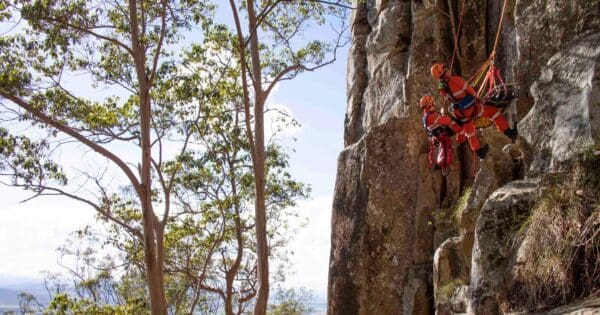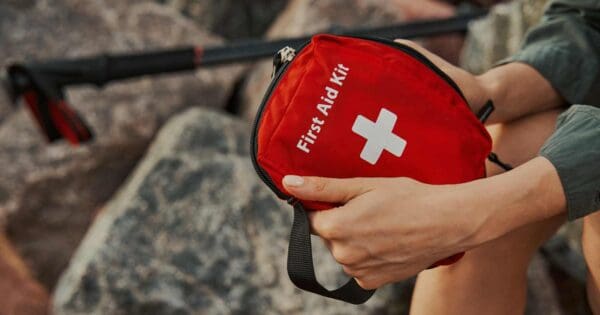There are many reasons why a hiker might need a helicopter search or extraction, all involving situations where they are unable to safely reach help on their own. Here are some of the most common reasons:
Medical emergencies
- Injuries. Serious injuries like broken bones, head trauma, or severe sprains can immobilise a hiker and prevent them from walking out.
- Medical conditions. Sudden illness, altitude sickness, or pre-existing conditions can worsen on the trail, requiring immediate medical attention.
- Exposure. Dehydration, hypothermia, or hyperthermia can all become life-threatening in harsh conditions, warranting a quick rescue.
Environmental dangers
- Dangerous terrain. Getting lost in remote areas, falling from cliffs, or encountering impassable obstacles can trap a hiker.
- Weather events. Sudden snowstorms, flash floods, or other extreme weather can make escape impossible and put hikers at risk.
- Wildlife encounters. Animal attacks or encounters with aggressive wildlife (while uncommon in Australia) can leave a hiker injured or trapped in fear.
Lost and disoriented
- Navigation mistakes. Misreading maps, losing the trail, or simply becoming disoriented can lead to becoming lost in the wilderness.
- Exhaustion. Fatigue and low energy levels can hinder a hiker’s ability to find their way back or even continue walking.
- Darkness. Getting caught out after dark with limited resources can make finding the way out extremely difficult.
Remember. Helicopter search and extraction should be considered a last resort. It’s crucial to be well-prepared for your hike, plan your route carefully, and pack appropriate gear and supplies. Always carry a map and compass, know how to navigate, and communicate your plans to someone before you set off.
However, if faced with a situation where your safety is at risk and self-rescue is not possible, don’t hesitate to call for help. Contact emergency services (Triple Zero (000) in Australia) and follow their instructions.
Helicopters can be lifesaving tools in these critical situations, providing a rapid and efficient way to reach medical care or a safe location, but their unique nature demands respect and proper understanding. For trip leaders and anyone venturing into areas where helicopters might be involved, following correct safety procedures are crucial for everyone’s well-being.
Landing and takeoff
- Clear a 7m x 7m landing zone free of power lines, trees, and obstructions. Dead branches, low-hanging wires, and even seemingly harmless twigs can become dangerous projectiles in the powerful downdraft created by the main rotor. Remember, clear not just the immediate landing area, but also the path the helicopter will take as it approaches and departs.
- Secure loose items. Hats, scarves, backpacks, and even water bottles can easily be ripped away by the downdraft. Make sure everything is securely fastened or stored away before the helicopter arrives. Even fully loaded packs can be lifted and tossed around, posing a serious safety hazard.
- Stay back at least 50m. The downdraft and sidewind from the rotors can be surprisingly strong. Keep a safe distance to avoid being knocked over or hit by flying debris. This distance also gives the pilot better visibility and maneuvering space.
- Signal the pilot clearly. If guiding the pilot, stand on the upwind side with your arms outstretched above your head, pointing towards the designated area. Use clear and concise gestures to avoid any confusion.

Winching operations
- Crew takes the lead. When a helicopter needs to winch someone or something onboard, a crew member will be lowered to the ground to manage the operation. Follow their instructions carefully and don’t approach the hovering helicopter unless explicitly told to do so. Remain at a safe distance and avoid getting tangled in the winch cable.
- Maintain distance. Keep everyone and everything well away from the hovering helicopter during winching operations. The downdraft and sidewind can be even stronger than during landing and takeoff, and the winch cable poses a serious hazard if anyone gets too close.
Being a passenger
- Follow instructions. When boarding a helicopter, listen carefully to the crew’s instructions and follow them to the letter. Pay attention to safety demonstrations and ask questions if anything is unclear. Buckle up securely and keep your seatbelt fastened until the pilot indicates it’s safe to unbuckle.
- Stay strapped in. Sudden turbulence or changes in altitude can happen quickly in a helicopter. Remain seated and keep your seatbelt fastened throughout the flight, even if it feels bumpy. This will help you stay secure and prevent injuries in case of unexpected movements.

Around grounded and hovering helicopters
- Get permission. Always wait for the pilot’s signal (thumbs up during the day or a flash of the landing lights at night) before approaching or leaving a helicopter. Don’t assume it’s okay to go near the helicopter just because it’s landed.
- Stay visible. Approach and depart from the front of the helicopter, remaining within the pilot’s field of vision. This helps them see you and ensures you’re not accidentally clipped by the rotors. If the helicopter lands on a slope, approach and leave downhill for better rotor clearance.
- Mind the slope. When approaching or leaving a helicopter on a slope, remember that the rotors can dip lower than you might expect, especially on uneven terrain. Always choose the downhill path to avoid walking under the blades.
- Heads down. Keep your head down and avoid looking directly at the rotors, especially on windy days. The blades can flap and dip unexpectedly, posing a danger to anyone standing upright.
- Secure loose items. Just like during landing and takeoff, secure any loose items you’re carrying to prevent them from being whipped away by the downdraft and creating a hazard.
- Protect your eyes. If dust, snow, or debris kicks up near the helicopter, crouch or sit down and wait for it to clear before moving. Don’t rub your eyes or try to look through the debris, as this could injure them.
- Tail rotor danger. Never venture near the tail section of a helicopter. The tail rotor spins at high speeds and is virtually invisible, making it extremely dangerous to approach. Always stay in front of the helicopter and avoid walking under the tail boom.
- Carry equipment safely. When carrying long items like stretchers, skis, or poles, keep them parallel to the ground and below your waist. This prevents them from being caught in the downdraft and potentially hitting someone. Grip them firmly with both hands to maintain control.
Don’t attract unnecessary attention
If light aircraft or helicopters are operating nearby but not searching for your group, it’s important to avoid interfering with their mission. Here’s what you need to know:
- Stay calm and don’t wave. These aircraft might be involved in another search effort, and frantic gestures can distract them from their task. Focus on your own safety and stay within your planned route.
- Observe their movements. If they see you, they’ll likely circle a few times to get a better view. Watch for any dropped message pads with instructions or questions, such as: “Have you seen a group of two female adults and four children?”, “If so, please point in the direction you last saw them.”
- Follow instructions clearly. If they drop a message, respond accurately and stay put until they give you further directions. Even if they don’t land or interact directly, your location will be noted and relayed if needed.
- Prioritise your own safety. Don’t chase the aircraft or leave your designated area just because you’re not their immediate focus. Continue practicing safe outdoor practices and stick to your planned route.
- Remember. These aircraft have limited resources and time. Respect their mission and focus on your own safety while they conduct their search. By staying calm and cooperative, you can help ensure successful rescue efforts for others. Stay aware, stay safe, and know when to wave and when to simply watch.
Getting noticed by search aircraft
- Create bright signals. Lay out large, brightly colored material in open areas to make yourselves visible from the air. Use materials like tarps, blankets, or even trash bags in contrasting colors like orange, yellow, or red.
- Smoke signals. During the day, build a smoky fire to attract attention. Remember to choose a safe location away from flammable materials and extinguish it completely when help arrives.
- Use of arm signals. Arm signals are used to communicate with search and rescue aircraft. When in distress, both arms raised in a “V” shape is the universally recognised signal for distress and the recommended choice. Keep your arms raised overhead for maximum visibility. A single arm raised high can be confused with greeting and is not a universally recognised distress signal. Avoid using it for distress. If you don’t need help, cross one arm over your chest with the other pointing upwards: This signifies “No” or “Don’t need help.” It’s important to be clear and avoid ambiguity.
- Waving and reflecting. Wave brightly colored objects or use a mirror to reflect sunlight towards the aircraft. This can help catch their attention, especially if you’re in a densely forested area.
- Night signals. At night, build a large, blazing fire that is easily visible from above. Alternatively, shine a torch (search crews often use night vision equipment, so a bright beam can be effective). Remember to aim slightly above the aircraft to avoid blinding the pilot.
- Don’t assume you’re seen. Even if illuminated by the searchlight or circled by the aircraft, you might not be spotted. Remain vigilant and continue signaling until you receive confirmed communication from the search team.
Assisting search efforts
- Report relevant information. If your group has information about a search underway, call Triple Zero (000) and ask for Police. Any details you can provide, such as last known location, potential hazards, or weather conditions, can significantly aid the search efforts.
- Remember limitations. A helicopter might not be able to land even if the ground looks clear. Factors like fuel weight, altitude, temperature, wind strength, and the number of personnel on board can affect their capabilities. Don’t be discouraged if a landing isn’t possible – help is still on the way, even if it arrives from the ground.
Final word
Helicopters are vital tools in search and rescue, but safety must always be the top priority. By following these simple procedures, everyone involved can navigate these situations safely and effectively. Remember, when working with helicopters, take it slow, think clearly, and watch the pilot and crew for instructions. Keep your head down, follow their directions precisely, and trust their expertise. By working together and prioritising safety, everyone can return home safe and sound.
Images: VICSES Bacchus Marsh Unit (Victoria)





